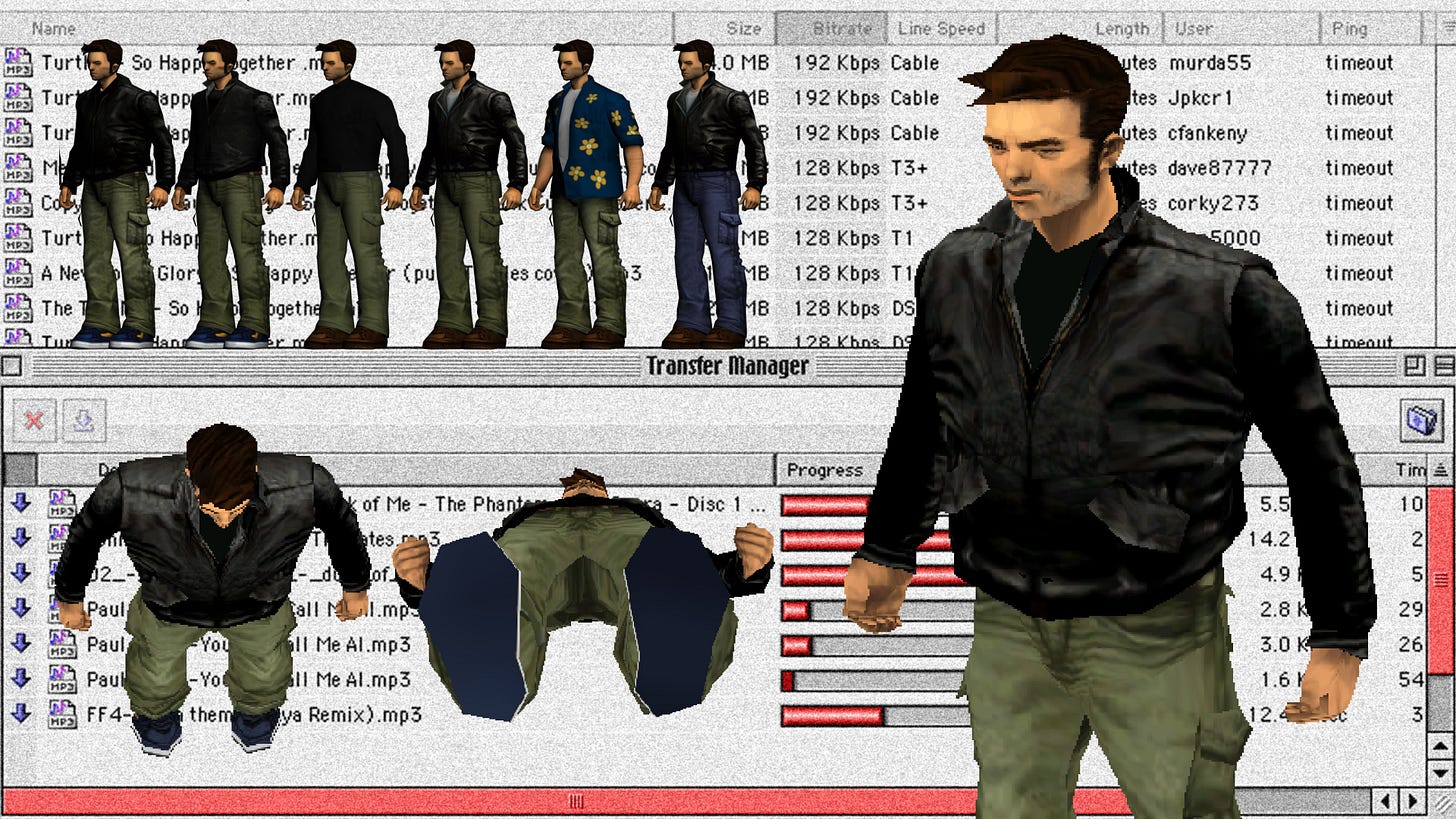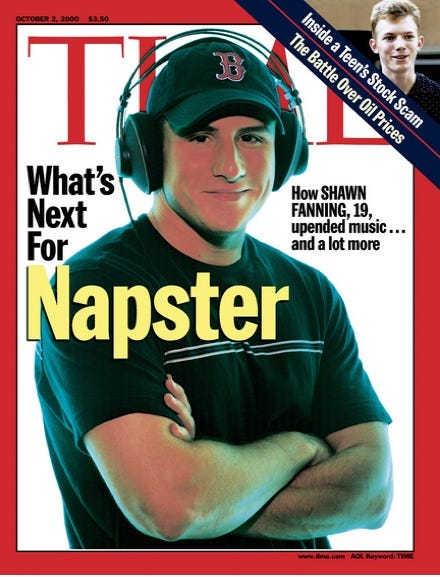The Napster-ification Of Digital Fashion (1/2)
Counterfeits on GTA & Roblox mimic the illegal MP3s of the '00s
This is an article in partnership with SQUAD LABS.
In 1999, a lot changed in the music industry. Lauryn Hill made history as the first rapper to win Album of the Year at the Grammys, Woodstock '99, intended to revive the legendary '70s festival, devolved into catastrophe and a notorious P2P file-sharing platform, Napster, began distributing digital audio files, better known as MP3s. They looked and sounded like the CDs everyone was buying, except on Napster, they were free. Despite being illegal, Napster changed everything. All of a sudden, record labels were reckoning with the future of music consumption. Out with CDs, in with digital files. “The music industry went from suing Napster to working with platforms (Spotify, Apple),” says Micael Barilaro, Brand Innovation expert (ex. VP Brand Innovation, Gucci). “Fashion could take a similar path.”
If Napster started the streaming revolution, then video games might be the catalyst for a similar uprising within digital fashion. On UGC (User Generated Content) platforms like Roblox and Minecraft the next generation of designers are creating their own digital clothes, training on software like Photoshop in place of sewing machines, cutting the fabric of the internet to create deeply imaginative designs. Just as Napster didn’t wait for the record labels, they don’t wait for brands to show up. Even Grand Theft Auto V, though not technically a UGC platform, has become an essential virtual world for digital fashion bootleggers thanks to its dedicated modding community. “We spend a lot of time dressing for the screen,” says Edmond Lau, Founder of Esoteric, a virtual closet and style aggregator that helps users manage, wear and shop curated designer digital fashion. “The creation of these bootleg designer items in-games is to signal status, or to express personal identity.”
Grand Theft Auto V: Break It To Make It
The true renegades of the gaming sphere are modders. Before UGC games welcomed player creations and offered the tools to do so, enthusiast hackers would hijack game code or build their own complementary software. This allowed them to make their own creations, be it games, artworks or clothes. GTA V has been a focal point of the modding community for many years. Due to the lack of official editing tools released by the game’s publisher, Rockstar Games, modders would often collaborate on various fan sites, creating their own documentation. The modding community is akin to the Wild West of early file sharing platforms like Napster. Modders don’t ask for permission, they break systems to get what they want.
Napster’s founders, Sean Parker and Shawn Fanning, were very much modders themselves, hacking at programs and building their own countercultural file-sharing software. GTA V’s community of modders is a big reason why the game has remained in the cultural zeitgeist and their consistent dedication to updating the game is reflected in their obsession with streetwear. Brands like Gallery Dept and Cactus Jack are showing up regularly, with collections recreated in painstaking detail, such as the Cactus Jack x Sp5der collection which look just as good as their physical counterparts. “People just want to be able to wear their own clothes in GTA,” says Lau.
GTA VI is rumoured to finally have official editing tools, making it a bonafide platform for UGC. This could be a watershed moment for in-game digital fashion. With the high fidelity graphics we can expect of GTA VI, branded digital clothes will look premium. Meanwhile, low fidelity UGC environments like Roblox require a much lower design lift to create digital fashion. Though some brands have been hesitant to come on board, these lower barriers for entry into digital fashion have generated a groundswell of counterfeit creators and bootleggers.
The Roblox Marketplace: Ground Zero For Digital Bootlegs
The Roblox Marketplace embodies the same early ‘00s thrill of scrolling through Napster. Just as you could find all your favourite pirated music, you can now find all your favourite counterfeit brands on Roblox. If you search for ‘Louis Vuitton’ in the market place you’ll find ski masks, bikinis and box logo red Supreme x LV shirts for a variety of prices. Some, such as the “Expensive Louis Vuitton T-Shirt”, described by creator ityufff to be “for rich people only,” are priced as high as 788,888,888 ‘Robux’, the platform’s in-game currency, amounting at time of writing to $9,861,111. It’s easy to pass this off as ludicrous, but in the crypto rich communities of the internet, the flex of being able to drop insane money on a digital item with no real utility is a daily occurrence.
The best selling Louis Vuitton item on Roblox is a Louis Vuitton Top. Made by TAFITA12, their store is also filled with other bootleg items, everything from Hello Kitty to Thrasher. The majority of counterfeits follow a fairly simple formula, take the logo or monogram and slap it on a standard clothing piece. “Just like the physical fashion industry, there are always dupes and copies,” says Morgan Evans, Director of Fashion & Beauty at Karta Games. “They are there as a visual zeitgeist of the real world and what is popular.” In this sense the luxury fashion industry might only have itself to blame. By leaning into what sells, many have reduced their design down to the bare minimum, white logo tees, or baseball caps, symptoms of a more general ‘mehification’ of luxury we have observed in recent years. In lieu of craftsmanship, replication, and thus degradation, becomes easy on Roblox.
Interestingly enough, the degraded aesthetic is actually preferable by most players. The most beloved items on the Roblox marketplace range from the downright creepy, like the “Emoji Mask” from Homemade_Meal, to the outright dumb, like the popular “Alien Carrying You” costume from Reverse_Polarity. Millions of players run around in these kinds of items, all tapped into the same esoteric joke intelligible only via deep set brain rot. When it comes to counterfeits players, such as dat-boi666 enjoy leaning into the broken and janky feel of Roblox’s lo-fi aesthetic, hence the “Gucci smart toilet”, which is actually a Louis Vuitton toilet. Counterfeit products on Roblox don’t all just imitate, in some cases they mock as well.
While fashion brands might not be racing to Roblox to make their own branded toilet, there’s a lot of value to be extracted from leaning into the absurdity of the platform. Crocs turned their ugly clog into an ugly hat with their “Croc On Your Head” in-game item. They have sold 37,500 of these at an average price of 231 Robux - that’s over $108,375 exchanged. The marginal production and environmental cost of creating these in-game items is zero, yet they can be sold infinite times. Less waste, more money - it’s a late stage capitalist’s fever dream.
Yet, beyond quality concerns, why aren’t the biggest brands paying more attention? While Alo Yoga has a range of exclusive products called Limiteds, listed on the Roblox marketplace and adidas have made a game mode called Outfit Creator, allowing players to customise their own merch, they remain the exception. “There are a few brands that embrace this new digital fashion revolution, and there are the rest that are blind to it,” says Lucas Feussner, Lead of Technology and Innovation at The Midnight Club. “A lot of them have no idea that their product is actually circulating on Roblox.” Say you’re a decision maker at one of these fashion brands. All of a sudden you’re made aware of the swathes of counterfeits mimicking your brand. Roblox will only remove a potentially IP infringing item if the rights holder files a takedown report, but rather than trying to punish bootleggers, or to beat them at their own game, what potential could there be in joining forces with them?
“I think brands need to take a pragmatic approach to enforcing IP,” suggests Edmund Lau. “UGC is so ubiquitous, it's hard to be strict with it - but the bigger reason I see for not taking a hardline stance against these bootlegs is that it would inhibit affinity and loyalty from potential customers.” Skibidi Toilet, a YouTube short series that has become the poster child of brain rot, takes a pragmatic approach. Taking the world by storm in 2024, the online series mutated into a 360 brand with action figurines, drones and skate decks. Roblox was the kerosene can behind Skibidi Toilet’s cultural inferno. With thousands of unofficial games, emotes and clothes available on the platform, Skibidi Toilet has elected to lean in. Instead of tearing things down, they’ve decided to either leave things be or better yet, collaborate, such as their official collaboration with Roblox designer WhoseTrade on a “banana toilet” in-game item.
Could counterfeit actually become collaboration? Not beating, but joining with IP violators certainly takes place offline. Following a lawsuit in the early 00’s over a skateboard deck featuring the LV monogram, in 2017 Louis Vuitton began its official collaboration with Supreme. In 2018, Gucci worked with Dapper Dan, a Harlem based tailor who famously used Gucci’s monogram in his original custom designs back in the ‘80s. If the next generation of fashion designers are emerging on Roblox, why couldn’t the same kinds of collaboration make sense? “In this incredibly fast paced space of UGC gaming, embracing and actually connecting with the parody nature of it would work incredibly well,” says Morgan Evans. “I want to see the first IRL/URL fashion brand born from one of these platforms.” If fashion brands and publishers alike play the role of enabler rather than enforcer of digital fashion, might this finally usher in the new era? First, the brands need to find their Dapper Dan.
Part 2 looks at one particular fashion brand making a case for the new era of IRL/URL fashion.
If you would like to get in contact for strategy or editorial related projects, please reach out to james@drawndistant.com







